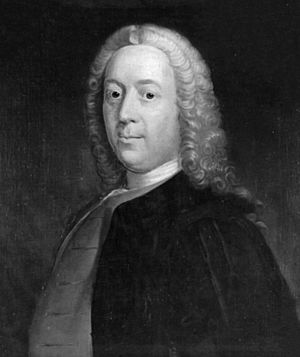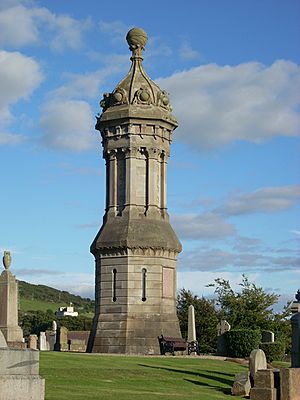Robert Simson facts for kids
Quick facts for kids
Robert Simson
|
|
|---|---|

Robert Simson
|
|
| Born | 14 October 1687 |
| Died | 1 October 1768 (aged 80) His college residence at Glasgow
|
| Resting place | Ramshorn Cemetery |
| Nationality | British |
| Alma mater | University of Glasgow |
| Scientific career | |
| Fields | Mathematics, especially geometry |
| Institutions | University of Glasgow Christ's Hospital |
| Notable students | Maclaurin Matthew Stewart William Trail James Williamson (mathematician) |
| Influences | Edmond Halley |
Robert Simson was a smart Scottish mathematician. He lived from 1687 to 1768. He taught mathematics at the University of Glasgow. A special line in geometry, called the Simson line, is named after him.
Contents
Robert Simson's Early Life and Education
Robert Simson was born on October 14, 1687. He was one of many children in his family. His father, John Simson, was a merchant in Glasgow.
In 1701, Robert started studying at the University of Glasgow. He planned to become a church minister. He studied subjects like Latin, Greek, and natural philosophy.
How Robert Simson Discovered Math
Mathematics was not a main subject at the university back then. But Robert found a book by Euclid called Elements. This book was about geometry.
He became very interested in math, especially geometry. His passion for numbers and shapes impressed the university leaders.
Becoming a Professor of Mathematics
The university offered Robert the job of mathematics professor. The previous professor had left. Robert felt he needed more training in math.
So, he turned down the offer at first. He agreed to take the job a year later. During that year, he wanted to learn even more about mathematics.
Robert Simson's Time in London
Robert Simson spent a year in London. He studied at a place called Christ's Hospital. While there, he met many important mathematicians.
One of the most important people he met was Edmond Halley. Halley was a famous astronomer and mathematician. He is known for Halley's Comet.
Robert Simson's Teaching Career
Robert Simson became a professor at the University of Glasgow in 1711. He was 23 years old. His first job was to create a two-year math course.
He taught many topics, including geometry, algebra, and optics. Some of his famous students included Colin Maclaurin and Matthew Stewart.
In 1761, Robert Simson retired from his teaching job. Another one of his students, James Williamson, took over his position.
Robert Simson's Math Discoveries
In 1753, Robert Simson noticed something interesting. He saw that as Fibonacci numbers got bigger, the ratio between them got closer to the golden ratio.
The golden ratio is a special number in math. It is about 1.618. It appears in nature, art, and architecture.
Robert Simson's Personality and Later Life
Robert Simson was a tall man. Even though he was very smart, he was modest and humble. He did not brag about his own work.
He liked spending time with friends. He even started a weekly dinner club. He also loved plants and was an expert in botany.
Robert Simson never got married. He passed away on October 1, 1768, at the age of 80. He died in his home at the university.
He was buried in Ramshorn Cemetery. His library, full of math books, was given to the university.
Honoring Robert Simson
Years later, in 1865, people raised money for a monument to Robert Simson. The University of Glasgow helped pay for it.
The monument was designed by Frederick Thomas Pilkington. It is a large, eight-sided structure. It stands on a hilltop in West Kilbride cemetery.
Robert Simson's Important Works
Robert Simson helped us understand old math books better. He created new versions and explanations of works by ancient geometers.
Euclid's Porisms and Conic Sections
One of his first published works was about Euclid's Porisms in 1723. Porisms are special types of geometry problems.
He also wrote Sectionum conicarum libri V. in 1735. This book was about conic sections. Conic sections are shapes like circles, ellipses, and parabolas. Parts of this book were translated into English.
Apollonius's Locorum Planorum
In 1749, he published Apollonii Pergaei locorum planorum libri II.. This was his effort to bring back a lost book by Apollonius. Apollonius was another famous ancient Greek mathematician.
Euclid's Elements
In 1756, Robert Simson published his own version of Euclid's Elements. This book was very important for a long time. It was the main textbook for learning Euclid's geometry in England.
After Robert Simson died, more of his works were printed. These included more of Apollonius's and Euclid's writings. They also had his ideas on Logarithms and other math problems.
See also
 In Spanish: Robert Simson para niños
In Spanish: Robert Simson para niños


